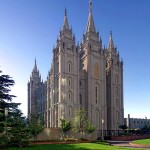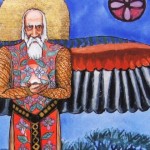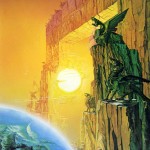Each of the individuals below is someone whose writings have has a profound influence on me, but who also are people who I admire because of their biography as well.
1. John Trevor (1855-1930)
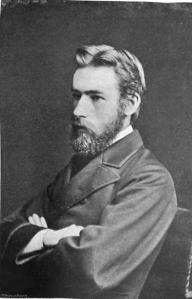
The founder of the British Labour Church. I’ve posted about Trevor before and will post about him again. I half suspect I am Trevor reincarnated (if I believed in reincarnation), our spiritual lives are so similar. I was led to Trevor’s autobiography by a quote in William James’ The Varieties of Religious Experience. Trevor describes a mystical experience there in terms that resonate deeply with me. But, what’s more, although Trevor begins his life as a Christian, when he looses his faith, he starts writing about religion in very “pagan” terms. I will save my quotes from his autobiography for future posts.
2. Jason W. Briggs (1821-1899)
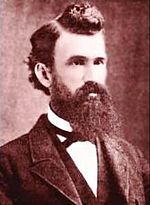
Briggs was an Apostle in the Reorganized Church of Jesus Christ of Latter-Day Saints. This was the church that broke off from the main body of the Mormon church after the assassination of Joseph Smith before the Mormons migrated to Utah. The RLDS Church repudiated polygamy from the start. I grew up Mormon and did not know about the RLDS Church until my early adulthood. The RLDS Church is more liberal than the Utah Mormon church, and therefore it appealed to me during my transition away from Mormonism.
Briggs was a theological liberal and embraced the “higher criticism” of the Bible (an example of which is the “Documentary Hypothesis”). Briggs believed that Scripture should be understood in the context of the time and place in which it was written. He took very seriously the LDS idea that revelation is a process that is never final. He also advocated for an honest acceptance of the fact that Joseph Smith had practiced polygamy, something that Smith’s widow denied, and his son, then Prophet of the RLDS Church, adamantly refused to accept. Briggs left the RLDS Church in 1886 after loosing his position as an Apostle. Briggs was a role model for me during my period of struggle with my Mormon faith.
I probably will not come back to Briggs for a while, so allow me to quote from him:
“Why do you make other men’s dreams your law, but trust not yours own? Prove all things, and whatever is proved to be good, hold fast, and the rest … leave in the ante-room of inquiry. … Now if instead of trying to believe, we should try to inform ourselves as to what is worthy of belief; … We often hear … ‘you musty not trust your own judgment.’ But we ask whose then shall be trust? … If we are told to repudiate human judgment altogether, we answer we have no other …” (“Skepticism — It’s Use”, The Messenger, Vol. 2, No. 8, p. 32, 1876)
“… no subject is too sacred to preclude examination.” (Saints’ Herald, Vol. 22, No. 2, p. 47)
“Inspiration is a development, dependent upon the faculties of the mind, and corresponds with the experience, and does not transcend it. … And when we reflect on how weak and varied the faculties of the mind are, it accounts for all the discrepancies manifest in the inspiration of different ages and different people.” (“Inspiration”, September 1876 Messenger)
“We have believed too easily and too much. As such as come to a sober second thought as are compelled to ‘reconsider’–growth implies throwing off, as well as taking on.” (1886 letter to Herbert Scott)
Briggs’ writing bears a strong resemblance to Emerson’s essay “Self-Reliance”, which I mention below.
3. George Smith (1840-1876)
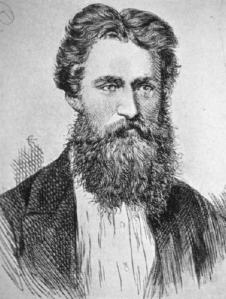
Smith was an amateur Assyriologist who translated the Gilgamesh epic. I first read about Smith in the book The Buried Book: The Loss and Rediscovery of the Great Epic of Gilgamesh by David Damrosch. Smith worked for a publishing house, but spent his lunch breaks at the British Museum studying Assyrian cuneiform tablets. Smith eventually was given a post at the Museum. He made a number of important discoveries in the tablets, but the most spectacular was the account of the Great Flood, a discovery which was of profound significance to the Christian world because it seemed to confirm the account in the Bible as historical. (Ironically, the account is now understood by scholars as evidence of a Babylonian influence on the Bible’s authors.) Smith’s discovery led to him receiving financing to go to the ancient site of the library of Assurbanipal at Nineveh, where Smith discovered the rest of the Gilgamesh epic, as well as the account of the descent of Ishtar to the underworld. Smith returned to Ninevah two more times, but died tragically on the third trip at the age of 36.
I love Smith’s story, because he begins without any formal education in ancient studies and, though sheer love and enthusiasm for the subject, goes on to make the most important discovery in his field, and fulfills what must have been his dream of excavating the great library at Ninevah. His discoveries also have great significance for modern Neopagans, especially the text of the Descent of Ishtar.
4. Thomas Taylor (1758-1835)
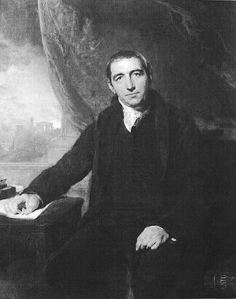
Taylor is most well known for translating into English for the first time the works of Plato and Aristotle, as well as numerous works of interest to Neopagans, including the Hymns of Orpheus, Apuleius’ The Golden Ass, and the writings of the Neoplatonists: Imablichus, Porphyry, Plotinus, Proclus, and Julian the Apostate. He is also the author of a book on The Eleusinian and Bacchic Mysteries. Taylor never achieved any professional success and his work was not appreciated in his lifetime. He struggled financially his whole life and had chronic ill health.
Interestingly, Taylor practiced his own private reconstruction of Classical pagan religion. His worship was more than merely aesthetic; it involved pouring libations to idols, and may have even included occasional animal sacrifice. Taylor has been credited with launching the Neopagan movement in 19th century Britain.
5. Jane Ellen Harrison (1850-1928)

Harrison was a proto-feminist and Classical scholar. She has been called Britain’s first female career academic. Harrison was a contemporary of James Frazer and one of the Cambridge Ritualists, together with Gilbert Murray, F. M. Cornford, and A. B. Cook.
One theme of Harrison’s writing to have a profound impact on Neo paganismis the conception of a chthonic matriarchal Greek religion which predated the Olympian patriarchal cult. Harrison was influenced in this regard by Nietzsche’s concept of Apollonian and Dionysian religion. According to Harrison, the goddesses in matriarchal religion were husband-less. Though they were accompanied by a son (sometime lover), this male figure was always subordinate to the goddess. He was defined by his relation to the Goddess, not vice versa. This notion was taken up later by Robert Graves. With the coming of Olympian theology, says Harrison, the relationship between the goddesses and the gods was reversed. Harrison’s ideas had a profound influence on Arthur Evans’ interpretation of his discoveries at Crete. Curiously, Harrison herself was somewhat ambivalent about the chthonic matriarchal religion, sometimes idealizing, sometimes condemning it.
Harrison’s influence on Neopaganism is evident in Z. Budapest’s The Holy Book of Women’s Mysteries. Through Budapest and Robert Graves, Harrison influenced Starhawk and an entire generation of Neopagan writers. I am going to be writing more about Harrison’s ideas in future posts.
6. Ralph Waldo Emerson (1803-1882)
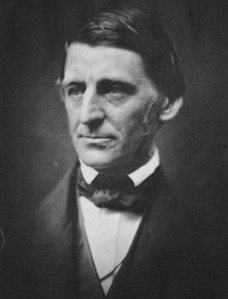
What can one say in a short space about such an important figure in American religious history? Certainly the Emerson and the Transcendentalists were to have an important influence on two movements which have been of profound significance in my life: Neopaganism and Unitarianism. What’s more, Emerson’s essay “Self-Reliance” was a revelation to me at a time when I very much needed encouragement in my separation from the faith of my childhood.
“Nothing is at last sacred but the integrity of your own mind. Absolve you to yourself, and you shall have the suffrage of the world. I remember an answer which when quite young I was prompted to make to a valued adviser, who was wont to importune me with the dear old doctrines of the church. On my saying, What have I to do with the sacredness of traditions, if I live wholly from within? my friend suggested, ‘But these impulses may be from below, not from above.’ I replied, ‘They do not seem to me to be such; but if I am the Devil’s child, I will live then from the Devil.’ No law can be sacred to me but that of my nature.”
Could there be a more pagan manifesto? Emerson’s challenge, “:if I am the Devil’s child, I will live then from the Devil”, is a personal motto of mine. It expresses a radical commitment to “live from within” in spite of any judgments from society.
But Emerson is also of interest to me because of his biography. I found his diary to be as interesting as he essays. In spite of his nature mysticism, he seems to have been tempted to (small “t”) transcendentalism, as suggested by a letter to him from a friend, Carlyle:
“You seem to me to be in danger of dividing yourself from the fact of this present universe, in which alone, ugly as it is, can I find any anchorage, and soaring away after Ideas, Beliefs, Revelations, and such like, into perilous altitudes. I wish you returned to your own poor century, its follies and maladies, its blind or half-blind, but gigantic toilings, its laughter and its fears, and trying to evolve in some measure the hidden godlike that lies in it. Alas it is so easy to screw oneself up into higher and ever higher altitudes of transcendentalism and see nothing under one but the everlasting snows of Himalaya, the earth shrinking to a planet, and the indigo firmament sowing itself with daylight stars; easy for you, for me. But whither does it lead? I dread always to inanity and mere injuring of the lungs.”
I have struggled with the same “Gnostic temptation”, so I identify with Emerson in this regard.
7. Carl Jung (1875-1961)
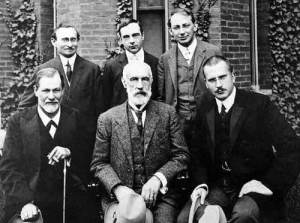
Jung has probably been the greatest single influence on my spiritual life as an adult. I have written about him in previous posts and will be writing a great deal more about him. But let me say here that what interests me about Jung as a person was that his ideas were born out of experience. He himself experienced a mental breakdown and a descent into the chaos of the unconscious, which is recorded in his “Seven Sermons to the Dead” and The Red Book. He also writes about his conviction of the reality of the numinous, though he readily admits that such a conviction is beyond the realm of rational proof.
“We find numberless images of God, but we cannot produce the original. There is no doubt in my mind that there is an original behind our images, but it is inaccessible. We could not even be aware of the original since its translation into psychic terms is necessary in order to make it perceptible at all. How would Kant’s Critique of Pure Reason look when translated into the psychic imagery of a cockroach? And I assume that the difference between man and creator of all things is immeasurably greater than between a cockroach and man. Why should we be so immodest to suppose that we could catch a universal being in the narrow confines of our language? We know that God-images play a great role in psychology, but we cannot prove the physical existence of God. […]
“Speaking for myself, the question whether God exists or not is futile. I am sufficiently convinced of the effects man has always attributed to a divine being. […] I am well satisfied that I know experiences which I cannot avoid calling numinous or divine.”
In a future post I will write about living people who inspire me.






